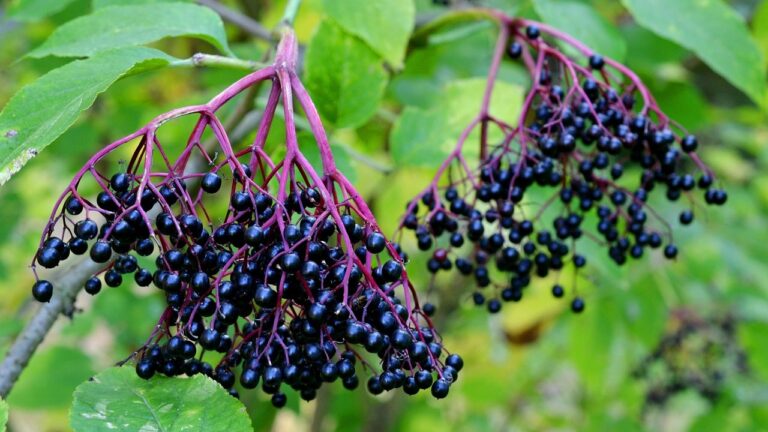Elderberries are native to the Midwest, but the commercial cultivation of the crop is relatively recent, and saw a big increase during the coronavirus pandemic. That has the burgeoning industry wondering if its future is as a small, niche crop or something bigger.
Four years ago, Alan Helland planted rows of elderberry shrubs to help diversify his family farm.
Today they stand eye-high in neat rows and produce about 25,000 pounds of elderberries annually.
“It’s a portion of my farm income, 2.5 acres of new planting,” Helland said while showing a group of farmers around his Ashland, Missouri farm. “You know, it wouldn’t come up to making a living.”
Elderberries — a small, purple fruit with a slightly tart taste ― are native to the Midwest and became a commercial grown only within the last two decades. While the USDA doesn’t keep specific numbers on elderberry acres, Missouri leads the country with about 400 acres of elderberry farms, and Iowa and Illinois each have a couple hundred acres in commercial production.
But the berry has gained more popularity in recent years, and the industry is wondering whether elderberries will remain a small, niche crop or become something bigger.

“We’ve seen an explosive growth in the production and we’ve seen an explosive growth in the development of markets for this crop,” said Patrick Byers, a horticulturist at the University of Missouri.
A big part of that was the use of elderberries in nutritional supplements.
With high levels of antioxidants, fiber and vitamin C, the berry has a reputation for reducing cold and flu symptoms. That led to a big demand for elderberry supplements during the COVID pandemic.
“We saw a situation where consumer demand for elderberry products resulted in basically the exhausting of our supply of berries,” Byers said.
In fact, elderberry supplement products saw a 13% annual increase from 2019 to 2021. Elderberry products are now a $320 million a year business in the U.S., according to the American Botanical Council.
Elderberries are also being used in flavoring beer and wine, as a natural food coloring and in jams and jellies, Byers said.
Chris Patton, president of the Midwest Elderberry Cooperative, said with demand for elderberry products projected to grow by more than 30% by the end of the decade, now is the time for elderberries to go big.
He works with more than 150 farmers across the region and said collectively they could help make elderberries much more mainstream.
“We have to be able to do large scale commercialization so that we can meet the needs of the larger producers in the place of imports and meeting the high quality standards,” Patton said.
Just replacing half of the number of elderberries imported into the U.S. with American grown crop would be huge, according to Patton. He sees elderberries having the potential to be as big as cranberries, and end up in energy drinks, nutrition bars, and many other products.
But some elderberry advocates worry that going big could mean lower prices for farmers.
“They say we need to be in drinks, we need to be in all these big outlets that people are pushing,” said Heather Wilson, a sales and social media manager for River Hills Harvest, a Missouri-based company that makes elderberry products and gifts.
“But at the same time, that’s gonna drop our price. And again, you’re gonna have to farm 40 acres of elderberries to just make the same amount that you could make right now on two or three acres,” she said.
Wilson believes the fruit’s future is probably stronger in very small-scale producers who do more than just grow the crop, such as pick-your-own farms and agri-tourism where elderberries are part of something that showcases rural life.
She highlights East Grove Farm in southeast Iowa that has made a successful business making elderberry mead and hosting music events.
“If you’re not expanding out that much and you can sustain yourself with just your community, you’re gonna get a lot more per pound of berries than you’re going to get if you’re just selling them wholesale to somebody else,” Wilson said.

But for farmers like Alan Helland, having the option to either stay small or be part of something bigger might be the most promising way to develop elderberry markets and farms.
“If it stays something that can be profitable for somebody on a couple acres, you know, kind of your thing,” he said, “but then, if it’s organized correctly, I think there can also be the farmers who are doing, you know, 45 acres of it.”
Helland said both options make it possible for farmers to grow a crop for the love of it.
This story was produced in partnership with Harvest Public Media, a collaboration of public media newsrooms in the Midwest. It reports on food systems, agriculture and rural issues. Follow Harvest on Twitter: @HarvestPM
9(MDM5MjE5NTg1MDE1Mjk1MTM5NjlkMzI1ZQ000))

